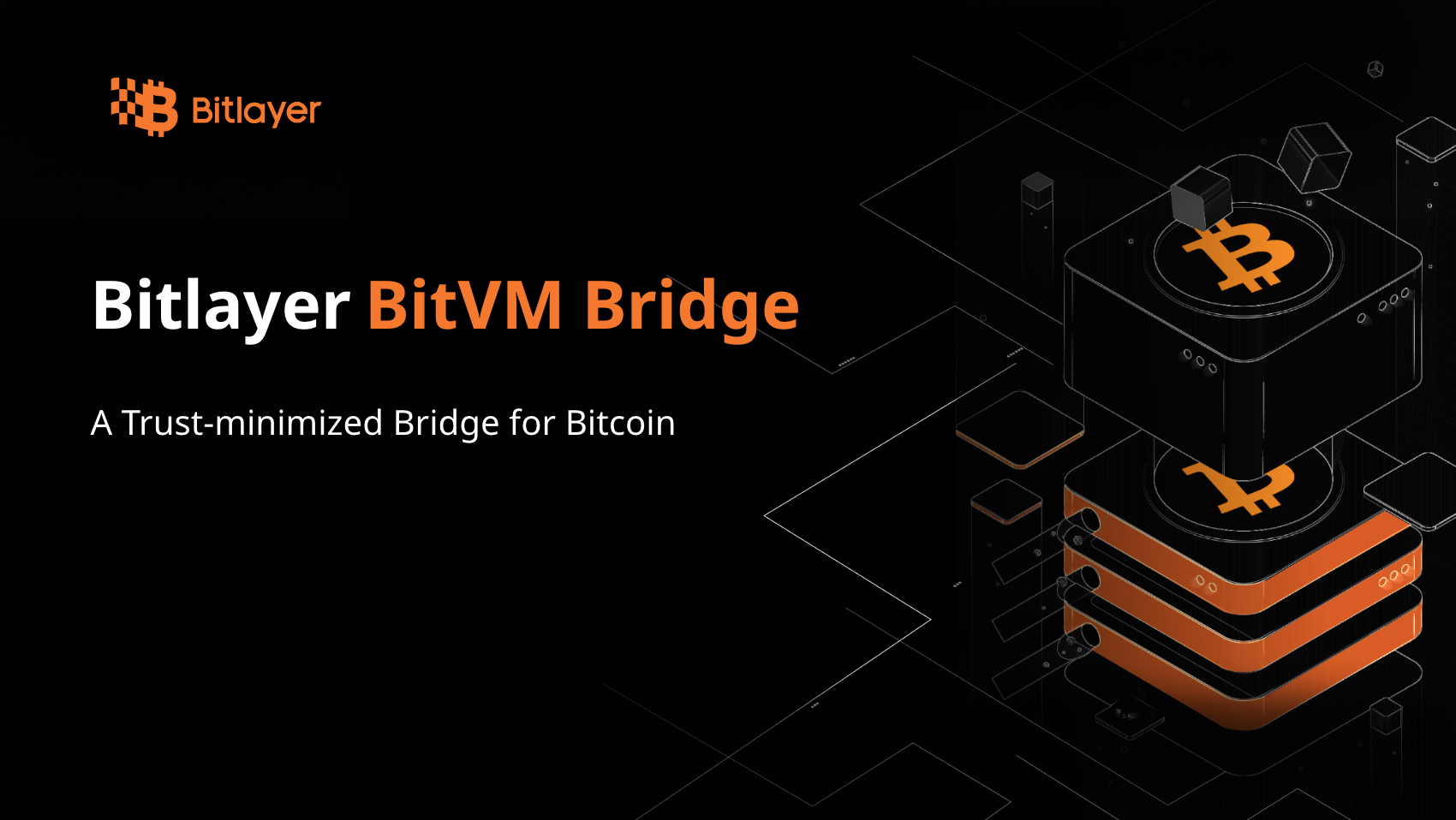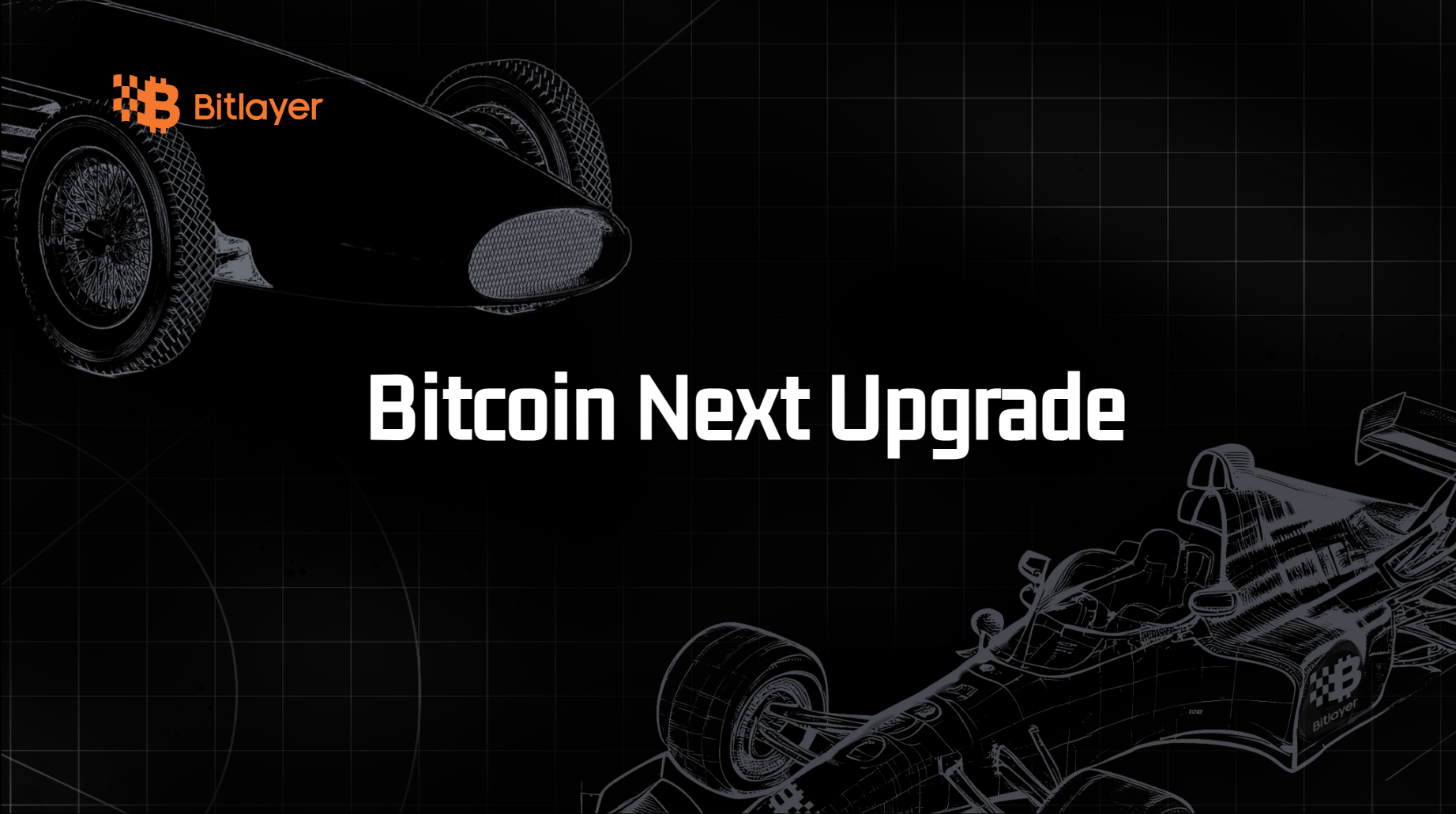
A Brief Report on Bitcoin's Next Upgrade for All
A Brief Report on Bitcoin’s Next Upgrade for All
Introduction
Discussions about Bitcoin’s next upgrade have been ongoing, but as of December 2024, the community has yet to reach a consensus on whether to upgrade, what problems the upgrade should address, or what functionalities it should introduce. The debate remains polarized, resembling a political stalemate.
In this deadlock, several interesting phenomena have emerged:
- A portion of the community actively pushes for upgrades. Driven by information asymmetry or commercial interests, some members frequently advocate for specific opcodes, and certain projects even depend on opcodes that “might” appear in the future.
- A significant number of pragmatic ecosystem developers have made considerable cryptographic and engineering efforts to expand Bitcoin’s potential, all without assuming protocol upgrades.
- Voices advocating for slow upgrades or outright opposing upgrades are also substantial.
These phenomena highlight that the topic of upgrades is highly popular within the Bitcoin community. However, they also reveal that many community members lack a comprehensive understanding of the complete process of a Bitcoin upgrade. Additionally, there is limited awareness of how innovative cryptographic tools can enhance Bitcoin’s potential.The core purpose of this article is to break through this information asymmetry, align everyone’s understanding, and facilitate deeper discussions on the topic.
This article aims to define Bitcoin upgrades, trace historical developments to identify certain patterns, analyze current upgrade proposals, and provide readers with key takeaways. By presenting this information, the goal is to equip readers with a solid foundation in understanding the concept, history, and progress of Bitcoin upgrades, thus enabling more informed discussions and contributing to the eventual formation of community consensus.
The article strives to present facts objectively. However, as the author is a developer in the Bitcoin ecosystem and envisions greater possibilities for Bitcoin, certain viewpoints will be explicitly expressed on specific topics. Readers are encouraged to discern these perspectives critically.
Upgrade Overview: What and Why
What is a Bitcoin Upgrade?
Bitcoin’s whitepaper defines a protocol that operates a blockchain network composed of thousands of nodes following the Bitcoin protocol.
These implementations, or clients, come in various versions, with Bitcoin Core being the most widely used client, as shown by data from bitnodes.
Thus, the Bitcoin Core maintainers (referred to as Bitcoin-Core-Devs ) have significant influence over Bitcoin’s development.

Bitcoin node software consists of multiple modules, and upgrades are defined through Bitcoin Improvement Proposals (BIPs). When discussing Bitcoin upgrades, it usually refers to consensus protocol upgrades—modifications requiring agreement among the majority of the network’s nodes to avoid forks.
As illustrated below, Bitcoin’s consensus protocol modules and related BIP proposals are of particular interest in upgrade discussions.
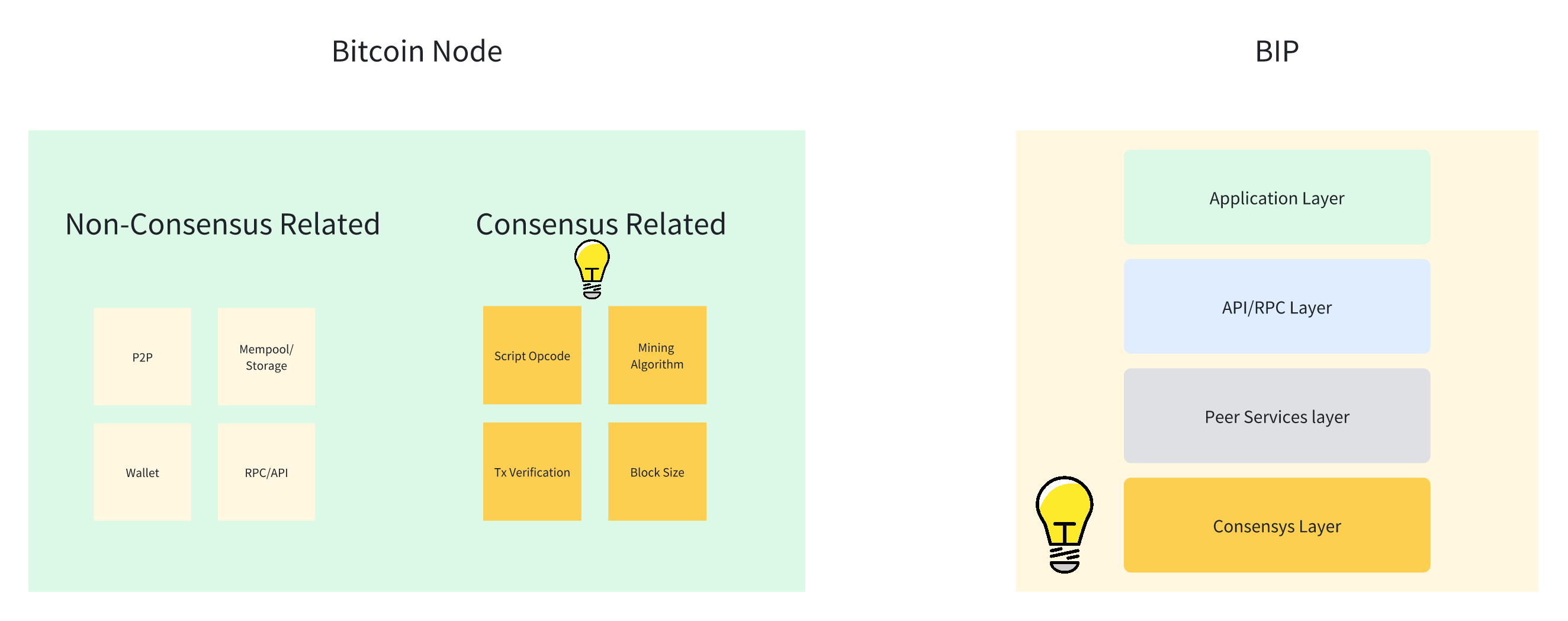
According to statistics from the Bitcoin GitHub repository , development activity is vibrant. However, most changes are unrelated to the consensus protocol and thus do not attract widespread attention.

Types of Consensus Upgrades
Per BIP-123, consensus protocol upgrades are classified into Soft Forks and Hard Forks:
| Feature | Soft Fork | Hard Fork |
|---|---|---|
| Compatibility | Compatible with old nodes | Incompatible with old nodes |
| Network-wide Update | Not always required | Required |
| Examples | SegWit/Taproot | Bitcoin XT/Bitcoin Cash |
Another intuitive way to interpret these is as follows:
- Soft Fork: Adds or strengthens rules (e.g., introducing new functionalities like Taproot addresses).
- Hard Fork: Removes or loosens rules (e.g., removing block reward limitations).
Soft Fork Process (BIP Workflows)
The previous two successful consensus upgrades (SegWit and Taproot) both utilized soft forks, avoiding significant community splits. Thus, this article focuses on soft forks, which enable upgrades while maintaining compatibility with older software.
The typical workflow of a BIP proposal leading to a soft fork is illustrated below:
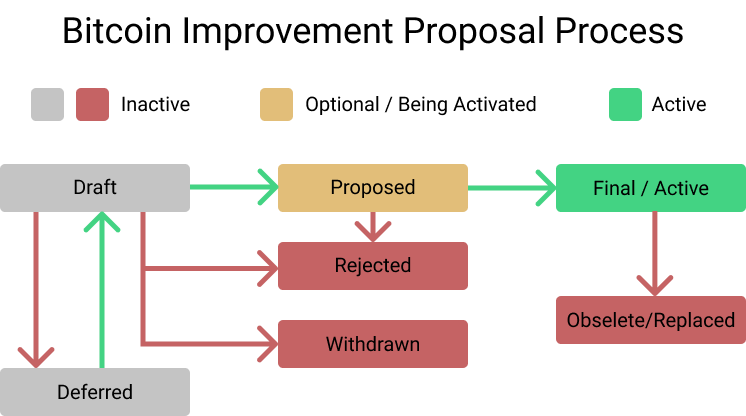
Source: https://river.com/learn/what-is-a-bitcoin-improvement-proposal-bip/
Soft forks often combine multiple BIPs into a single proposal. For example, Taproot incorporated three BIPs:
Timeline of the Taproot Upgrade
 Source: Kraken Intelligence, GitHub, CoinDesk, https://www.argoblockchain.com/articles/bitcoin-taproot-upgrade-explained
Source: Kraken Intelligence, GitHub, CoinDesk, https://www.argoblockchain.com/articles/bitcoin-taproot-upgrade-explained
Key milestones in Taproot soft fork:
- Corresponding BIPs proposed and reviewed.
- Bitcoin-Core-Devs submit a GitHub pull request.
- Code is reviewed, merged, and activation methods determined.
- The new Bitcoin-core client version was released.
- Miners signal via on-chain voting to approve the bip’s activation parameters.
- Block height reached, completing the upgrade.
It is important to note that this process is a retrospective summary based on historical observations, and in reality, there is no formalized consensus on this milestone.
Throughout the process, the Bitcoin Development Mailing List has played a pivotal role in consolidating consensus among various parties.
Why Upgrade?
As mentioned at the beginning of the article, there are currently three main perspectives within the community regarding upgrades:
- Proactive Advocates: This group has proposed numerous upgrade ideas, which will be analyzed in the sections below.
- Pragmatic Builders: They focus on solutions within the existing protocol, such as implementing Fraud Proofs (e.g., BitVM and its extensions), functional encryption (covenants and ZK-proofs via Bitcoin PIPEs ) and hash collisions (covenants via ColliderScript), etc.
- Conservatives: This group includes the TeamSlowAndSteady, which advocates for extremely slow and cautious upgrades (e.g., a 10-year cycle), and the Ossifiers, who oppose upgrades unless there is an existential threat like quantum attacks (see Is Ossification Good or Bad for Bitcoin).
The author conducted an analysis of the pros and cons of upgrading versus not upgrading.
| Consensus Change | Pros | Cons |
|---|---|---|
| Change | Technological Advancement, Enhanced Security, Expanded Use Cases | Risk of Forking, Increased Complexity |
| Unchanged | Stability and Trust, Avoids Split Risks, Minimizes Attack Surface | Technological Stagnation, Lacks Flexibility for New Demands |
As a pragmatic developer in the Bitcoin ecosystem, the author believes that fully exploring Bitcoin’s potential through cryptographic or engineering innovations within the existing protocol framework is indispensable. At the same time, from the perspectives of “sustainability” and “adaptability,” it is advisable to implement continuous upgrades as needed, provided the impact and security risks are thoroughly evaluated.
In-Depth Analysis of Upgrades
Stakeholders in Bitcoin Upgrades
In Bitcoin’s history, the Hong Kong Consensus (signed during the Bitcoin Roundtable in February 2016) identified three primary stakeholder groups:
- Bitcoin-Core-Devs
- Mining Pools
- Users and Ecosystem Developers (primarily exchanges, chip manufacturers, etc.)
As Bitcoin adoption has grown rapidly, the stakeholder landscape has evolved from this simple triad into a more fragmented and competitive environment. This is illustrated in the informative report from Analyzing Bitcoin Consensus: Risks in Protocol Upgrades.
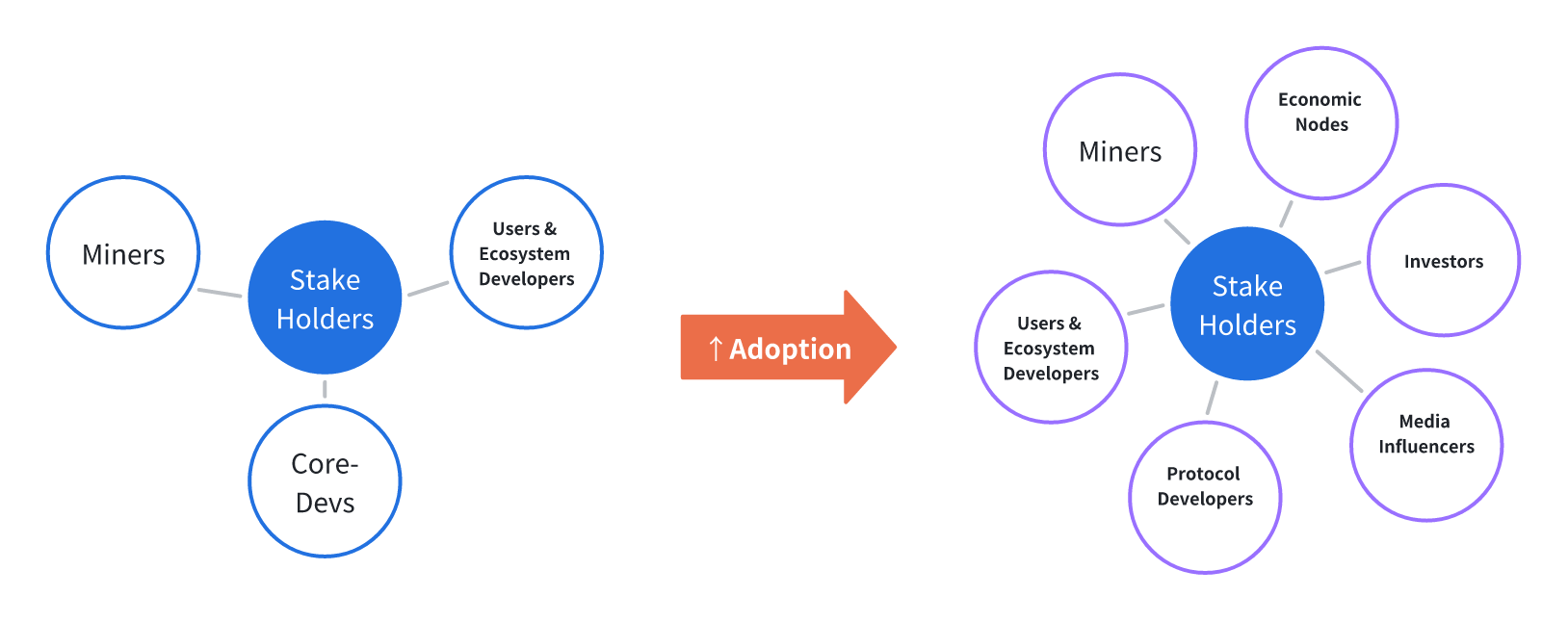
Among these stakeholders, several key roles are worth highlighting:
- Economic Nodes: These include major centralized exchanges (CEX), payment processors, and custodial service providers. Their stance on soft forks heavily influences what is considered “legitimate” Bitcoin and impacts adoption rates.
- Investors: With Bitcoin ETFs, institutional reserves, and even sovereign reserves becoming mainstream, this group has grown increasingly complex.
- Users & Ecosystem Developers: Following the Taproot upgrade, Bitcoin’s ecosystem has flourished, giving rise to protocols like Ordinals and numerous native applications and scaling solutions.
Key Observations on Stakeholders:
- Different roles at different stages: For instance, Ecosystem Developers actively push proposals, Protocol Developers exercise their authority over BIP reviews, while mining pools and economic nodes wield significant influence during activation.
- Commercial interests drive some proposals: Ecosystem Developers often propose and support upgrades aligned with their business interests. For example, proponents of Validity Rollup are inclined to support
OP_CAT.
History and Summary of Bitcoin Upgrades
Public data reveals multiple soft fork upgrades since Bitcoin’s inception.
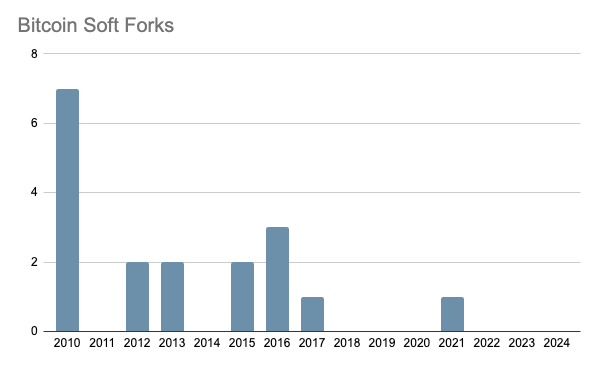
Data Sources:
From the chart, 2 conclusions can be drawn:
- Bitcoin’s protocol has become increasingly rigid, with the frequency of soft forks declining over time.
- Reaching consensus on upgrades now takes significantly longer.
Focus Areas of Soft Forks
Analyzing past soft forks and their associated BIPs, the following focus areas emerge:
| Focus Area | Examples |
|---|---|
| Scalability | SegWit/Schnorr |
| Privacy | Taproot/MAST/P2SH |
| Programmability | CLTV/Tapscript |
| Security | Disable Opcodes |
What Makes a Good Upgrade Proposal?
Based on the analysis above, a good upgrade proposal should:
- Uphold Bitcoin’s Core Role as a Payment System: Any upgrade must align with Bitcoin’s unique positioning.
- Strike a Balance Between Potential Benefits and Risks: It should be broadly acceptable and not polarizing.
- Have an Appropriate Scope: Proposals should neither be too trivial nor overly complex to implement.
- Timing: Upgrades should address pressing needs, such as SegWit addressing the scalability demand during its time.
Future Outlook
Proposal Classification
The author has compiled most of the active proposals, assigned focus area tags to them, and categorized them into four quadrants to provide readers with a visual understanding. Points to note regarding the classification:
- The four focus areas are not entirely isolated from one another. For instance, a BIP that enhances programmability might also contribute to scalability to some extent.
- A proposal may address multiple focus areas. For example, while OP_CAT primarily enhances programmability, its broader support comes from its role in enabling validity rollups.
- Determining which focus areas a proposal addresses requires a degree of “consensus” (inherently political). It’s important to note that there is no single definition, as different stakeholders may interpret the same proposal from varying perspectives.
- The second diagram is not a coordinate system; it categorizes proposals based on their tags. The attributes of the circles (such as size, position, or color) do not carry any specific meaning.
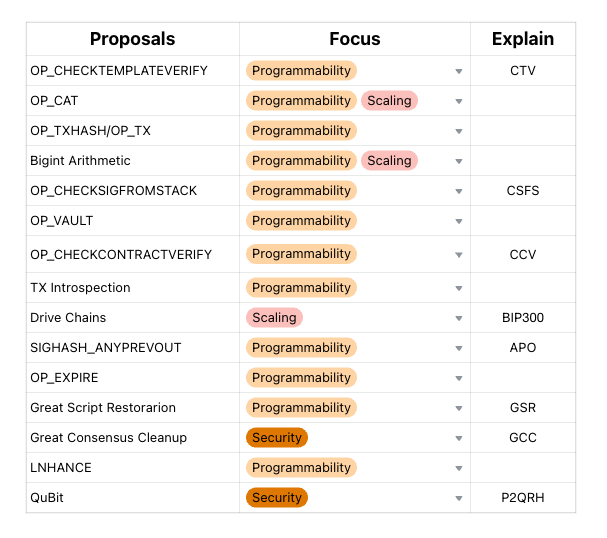
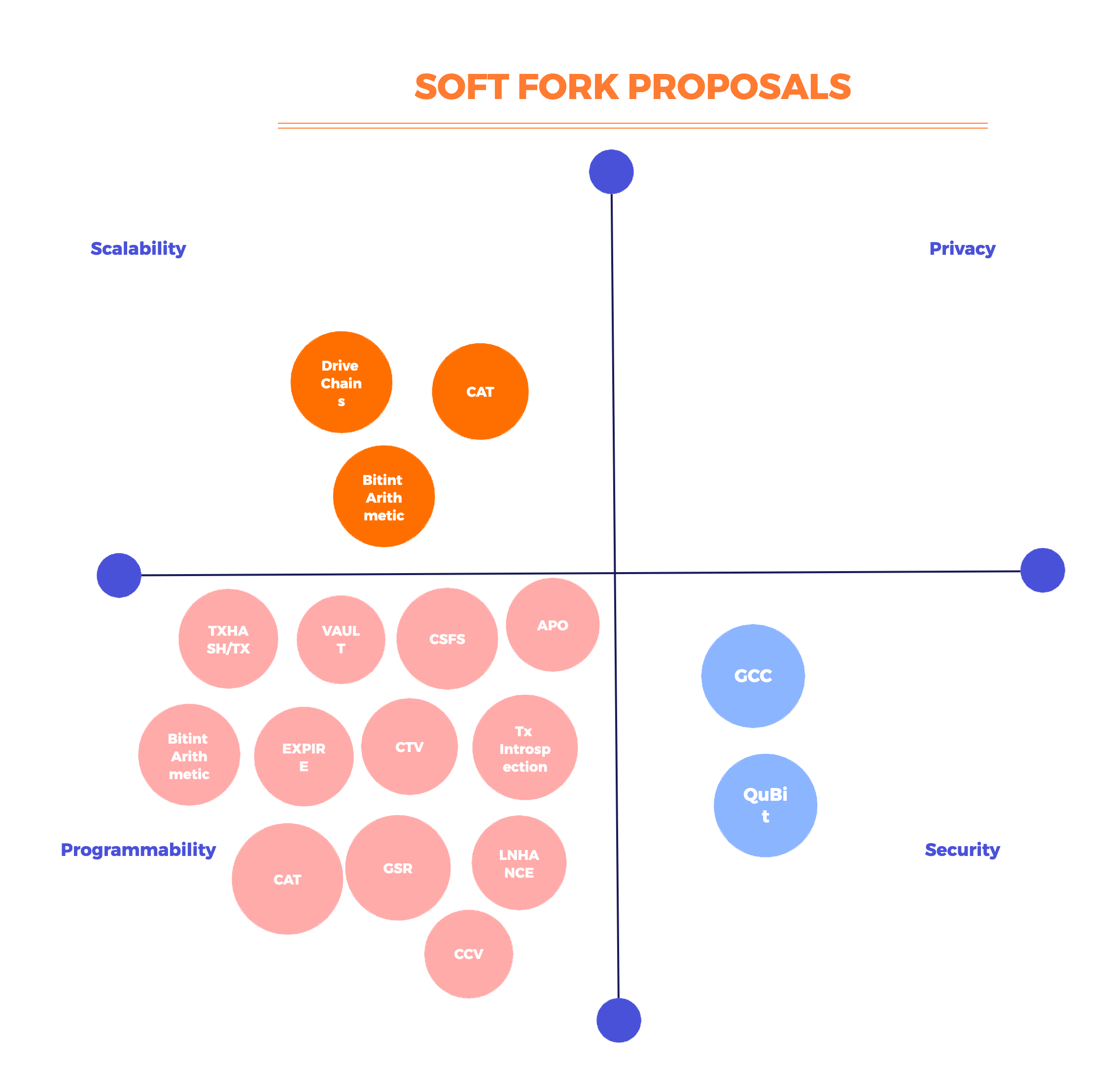
Community Sentiment
From the chart above, the community appears to have reached some consensus on the problems upgrades should address, particularly in two areas:
- Programmability: Enhancing UTXO programmability for use cases like covenants, vaults, transaction introspection, conditional payments, and script enhancements.
- Scalability: Improving Layer 2 scaling, with proposals divided into on-chain and off-chain verification solutions.
The Puzzle of Consensus
The author believes that the Bitcoin community has fallen into a consensus maze regarding the next upgrade due to the following reasons:
- Ossification: With a fully diluted value (FDV) nearing $2 trillion, stakeholders lean towards stability, as no one wants to bear responsibility for potential mishaps.
- Fragmented Stakeholders: Diverse interests and varying levels of influence at different stages make consensus elusive; even governments have emerged as stakeholders.
- Imperfect Governance Mechanism: As the earliest blockchain, Bitcoin lacks a highly refined governance mechanism; the community has also been unable to reach a consensus on the methods for activating soft forks.
- The role of Protocol Developers is inherently dynamic: While they may indeed reject certain proposals, it cannot be simply characterized as conservative or progressive.
- Lack of Urgency: With maturing blockchain infrastructure, there’s no overwhelming demand for immediate Bitcoin upgrades.
Conclusion & Takeaways
This article introduced the fundamental concepts of Bitcoin upgrades, provided an in-depth analysis of historical upgrades, and reviewed active proposals for the next upgrade. The causes of the current “consensus puzzle” were also identified.
Key takeaways:
- Pragmatic development while cautiously advancing upgrades; soft forks are preferable.
- Stakeholders are highly fragmented, leading to a conservative stance from the community.
- Discussions about upgrades must adhere to Bitcoin’s core value proposition.
- Scalability is just one of many focus areas for upgrades.
- Timing is critical—strong proposals will gain consensus more quickly.
- The community must explore improved governance mechanisms.
Acknowledgments
During the research, writing, and review process of this article, I received tremendous support, including from community members who, for various reasons, preferred not to be named. I extend my heartfelt gratitude to all of them.
Note: Given that some viewpoints in this article reflect personal preferences, the individuals listed below are NOT necessarily in full agreement with the content. This article does NOT intend to involve these generous community members in any political discourse.
Co-Editing and Reviewing (in alphabetical order):
- Adrien Lacombe
- Bob Bodily
- Bitlayer Research Team
- Domo
- Jeffrey Hu
- Red
- Ren Zhang
- Scott Odell
- Super Testnet
- Will Foxley
Feedback and Help (in alphabetical order):
Future Work
Throughout the process, the author has identified many issues worthy of further exploration, such as solutions for certain functionalities, research on specific proposals, and data support for certain viewpoints. These topics will be elaborated upon in subsequent articles in the series.
Reference
- https://bitcoinops.org/
- https://opnext.dev/
- https://groups.google.com/g/bitcoindev
- https://github.com/TABConf/6.tabconf.com
- https://petertodd.org/2024/covenant-dependent-layer-2-review
- https://blog.bitmex.com/a-complete-history-of-bitcoins-consensus-forks-2022-update/
- https://blog.bitmex.com/bitcoins-consensus-forks/
- https://github.com/bitcoin/bips/blob/master/bip-0123.mediawiki
- https://river.com/learn/what-is-a-bitcoin-improvement-proposal-bip/
- https://bitnodes.io/nodes/
- https://github.com/bitcoin/bitcoin/pulse/monthly
- https://river.com/learn/what-is-a-bitcoin-improvement-proposal-bip/
- https://trustmachines.co/learn/bitcoin-taproot-upgrade-basic-breakdown/
- https://www.argoblockchain.com/articles/bitcoin-taproot-upgrade-explained
- https://medium.com/@bitcoinroundtable/bitcoin-roundtable-consensus-266d475a61ff
- https://github.com/bitcoin-cap/bcap
- https://newsletter.blockspacemedia.com/p/four-takeaways-from-op-next
- https://blog.bitfinex.com/education/is-ossification-good-or-bad-for-bitcoin/
- https://arxiv.org/abs/2305.04079
- https://en.bitcoin.it/wiki/Covenants_support
